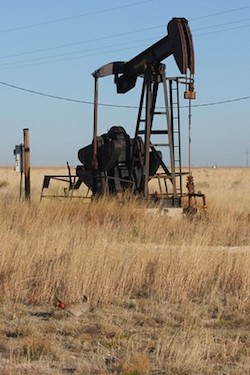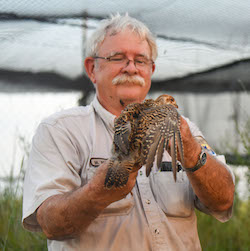SEJournal Online is the digital news magazine of the Society of Environmental Journalists. Learn more about SEJournal Online, including submission, subscription and advertising information.
 |
| A male lesser prairie-chicken performs its mating dance on a Kansas ranch. Displaying males expand red air sacs on either side of the neck to amplify their booming calls. Photo: Greg Kramos, USFWS via Flickr Creative Commons (CC BY 2.0). |
Perspective: ESA Inaction Spells Trouble for an Iconic Grassland Bird
By Mike Smith
The iconic lesser prairie-chicken, a member of the grouse family with a macho, foot-stomping mating dance, booming call and a special place in the cultural traditions of Native American peoples such as the Blackfoot and Plains Cree, is in serious trouble — and Endangered Species Act listing delays are making things worse.
One of the species’ two remaining populations is on the verge of extinction. The other is heading quickly in the same direction.
Fewer than 1,200 lesser prairie-chickens remain in the shinnery oak prairie and grasslands of Texas and New Mexico, and perhaps only 20,000 are left in the mixed-grass, shortgrass and sand sagebrush ecosystems of Colorado, Kansas and Oklahoma.
In June 2021, the U.S. Fish and Wildlife Service proposed that both populations be listed under the Endangered Species Act, or ESA — the southern group as endangered and the northern group as threatened.
A final ruling on the proposal was originally scheduled for June 2022. It is now months past due.
After numerous population studies, hearings and public comment periods, the listing decision is still in abeyance. During the delays, these colorful grassland grouse may have lost another 100,000 acres of habitat.
Protecting precious habitat, a massive challenge
The lesser prairie-chicken requires extensive areas of native grasslands without overhead structures like trees, cliffs or power lines where raptors may be lying in wait. Critical elements include leks — open areas where the birds gather in spring to procreate — and nearby areas with good cover and lots of food for raising young.
Agriculture, development and energy extraction
have taken a permanent toll on western prairie grasslands,
squeezing the lesser prairie-chicken out of the landscape.
But America has very little of that precious habitat left. Agriculture, development and energy extraction have taken a permanent toll on western prairie grasslands, squeezing the lesser prairie-chicken out of the landscape.
The Western Association of Fish and Wildlife Agencies, or WAFWA, is charged with the care of habitat for these birds and the creation of strongholds through a program of offsets and impact mitigation.
But the organization has been ill-equipped to carry out the mission.
The problem with outsourcing bird conservation to state agencies that are primarily in the hunting, fishing and game management field, and that manage and run state parks, is that rangers and administrators were not ready for the massive challenge of buying ranch real estate, managing permanent easements or creating mitigation credits for the oil and gas and wind energy industries that pay into a WAFWA fund for this purpose.
So most of the original energy industry money invested for land and conservation is gone. Meanwhile, at its recent summer meeting in Oklahoma City, the WAFWA reported a 20% decline in lesser prairie-chicken numbers since 2020.
Banking on the future
Conservation banking offers an alternative approach.
To protect the species, conservation bankers search out the lesser prairie-chicken’s special places and work with landowners to make permanent easements with funding for constant conservation over the life of the land.
 |
| An abandoned pumpjack looms above a male lesser prairie-chicken displaying on a lek near Milnesand, New Mexico. Photo: J.N. Stuart via Flickr Creative Commons (CC BY-ND-NC 2.0). |
NPR reporter Beth Wallis reported on one such partnership in a recent episode of the StateImpact Oklahoma podcast.
Some progressive energy companies are buying impact mitigation credits from conservation banks to get ahead of the issue and help the lesser prairie-chicken survive.
Land from private landowners costs a little more than the state agencies seem willing to pay. But advocates say it’s a price worth paying to save this bird.
Habitat Conservation Plans, or HCPs, which are approved by the U.S. Fish and Wildlife Service, are another way for private landowners and ranchers (primarily beef cattle producers) to get in the game and allow permanent easements for the bird.
About 70,000 acres are available in the lesser prairie-chicken’s range based on HCPs for wind power, solar, energy transmission, and oil and gas.
Science and politics
The lesser prairie-chicken is not alone in its misfortune.
Over the last 50 years, North America has lost 2.9 billion birds due to development and pesticide use, among other hazards. Populations of grassland birds have declined by 53%.
As bird numbers plummet, environmental journalists are increasingly likely to find themselves reporting on ESA decision-making.
Covering the ESA listing process for any species requires journalists to be part scientist — or at least have access to a great biologist — to discern the causes and consequences of species loss.
And journalists must be part detective, using investigative reporting techniques to unravel the complicated political interests at play. In the case of the lesser prairie-chicken, those include opposition from the oil and gas industry, and even solar and wind power companies.
Most observers believe this species will be listed eventually. But there is widespread speculation that the ESA decision is being withheld until after the midterm elections to shield the Biden administration from accusations of being against domestic energy production.
Meanwhile, lesser prairie-chicken habitat continues to disappear, along with the birds themselves.
SIDEBAR: Attwater’s Prairie-Chicken Provides Cautionary TaleFor those concerned about the fate of the lesser prairie-chicken, one of its close relatives provides a cautionary tale. The Attwater’s prairie-chicken, a subspecies of the greater prairie-chicken, is now functionally extinct. The only place where one can view this bird in the wild is the Attwater Prairie Chicken National Wildlife Refuge in Eagle Lake, Texas. (A small population found on private property in Goliad County, Texas, is not accessible to the general public.)
Attwater’s prairie-chickens once lived across the gulf coast prairies of Texas and Louisiana, but have lost 99% of their habitat. The much-reduced populations are increasingly vulnerable to natural mortality factors, like predation and weather events, and unnatural ones, like introduced fire ants. As a result, these birds are no longer able to survive without assistance. For the past few decades, the U.S. Fish and Wildlife Service has been trying to restore the Attwater’s prairie-chicken by breeding the birds in captivity and releasing them on their namesake wildlife refuge and the Goliad County property. The Houston Zoo, Caldwell Zoo, Sutton Avian Research Center and Fossil Rim Wildlife Center are successfully raising Attwater’s prairie-chickens for release into the wild. The total captive flock at these facilities numbers less than 200. Many of the released birds are unable to adjust to life in the wild. Biologists involved in the captive breeding program are working on solutions such as innovations to mimic habitat and help the fledglings adapt to the prairie. The ultimate goal is to establish sufficient wild populations to bring this bird back from the brink, but the problem of missing habitat remains. Just as with the lesser prairie-chicken, perhaps what remains for these grassland bird cousins is captive breeding or viewing these special birds at the zoo. To avoid a repeat of the Attwater’s saga, the U.S. Fish and Wildlife Service must list the lesser prairie-chicken so it will have the habitat it needs to survive. It is literally a life-or-death moment for the bird and the USFWS and those private landowners and state wildlife management experts who wish to save it. |
Mike Smith is the environmental reporter at Coastal Point newspaper in coastal Delaware, based in Ocean View. Smith serves on the board of governors at the National Press Club in Washington, D.C., where he’s been a member for 30 years. He has both his master’s and bachelor’s degrees in journalism from Northwestern University's Medill School of Journalism and studied political reporting at Columbia. Smith was an adjunct professor at the Reed College of Journalism at West Virginia University, where he created a course on environmental marketing. He has won writing awards from Quill & Scroll, the Dallas Morning News and, this year, from the Maryland | Delaware | DC Press Association, for environmental reporting on sea level rise and climate change.
[Editor’s Note: For more about prairie-chicken conservation, check out a mini-tour (including a video recording) on the subject from SEJ’s 2022 annual conference, which author Smith led and from which he drew material from for this article.]
* From the weekly news magazine SEJournal Online, Vol. 7, No. 39. Content from each new issue of SEJournal Online is available to the public via the SEJournal Online main page. Subscribe to the e-newsletter here. And see past issues of the SEJournal archived here.













 Advertisement
Advertisement 



